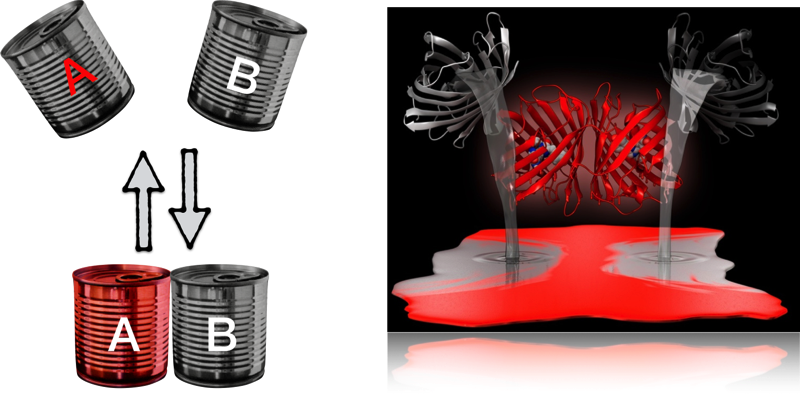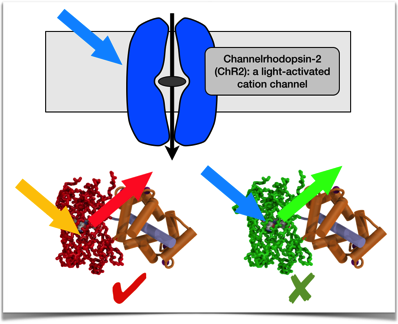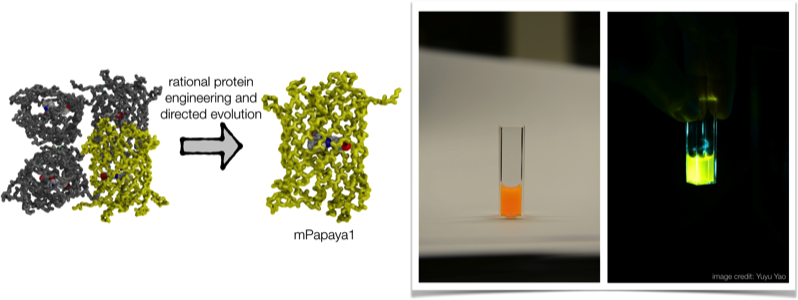The Campbell Lab at the University of Alberta
Engineering optogenetic tools for cell biology and neuroscience
Optogenetic reporters for cell biology and neuroscience

Our goal is to create new optogenetic reporters that will enable high-speed multicolour imaging of combinations of Ca2+, voltage, and countless other cellular activities in fish, rodents, and other model organisms. Most of our work in this area has focussed on expanding our multicolour series of Genetically Encoded Ca2+ indicators for Optical imaging (GECOs). However, we have recently expanded our efforts to include voltage reporters based on both fluorescent proteins and microbial opsins, and the neurotransmitters glutamate and GABA.
Representative Publications
- Hochbaum, Zhao et al., “All-optical electrophysiology in mammalian neurons using engineered microbial rhodopsins”, Nat. Methods, 2014. Accepted.
- Zhao et al., “Microfluidic cell sorter-aided directed evolution of a protein-based calcium ion indicator with an inverted fluorescent response”, Integr. Biol. (Camb), 2014, 6(7), 714-725.
- Wu et al., “Improved orange and red Ca2+ indicators and photophysical considerations for optogenetic applications”, ACS Chem. Neurosci., 2013, 4(6), 963-972.
- Hoi et al., “Highlightable Ca2+ indicators for live cell imaging”, J. Am. Chem. Soc., 2013, 135(1), 46-49.
- Zhao et al., “An Expanded Palette of Genetically Encoded Ca2+ Indicators”, Science, 2011, 333, 1888-1891.

Dimerization-dependent fluorescent proteins (ddFPs)
We recently introduced the ddFP concept as an alternative to FRET for detecting and imaging of protein-protein interactions in live cells. We continue to explore the wide-range of new applications made possible by this versatile new technology.Representative Publications
- Alford et al., “Dimerization-Dependent Green and Yellow Fluorescent Proteins”. ACS Synth. Biol., 2012, 1(12), 569-575.
- Alford et al., “A Fluorogenic Red Fluorescent Protein Heterodimer”. Chem. Biol., 2012, 19, 353-360.
Expanding the toolbox of spectrally orthogonal optogenetic actuators and reporters
One of the motivations for developing new colors of optogenetic reporter are new opportunities to combine the use of two reporters or a reporter and an actuator. One important example is combining ChR2 and a Ca2+ or voltage reporter for simultaneous stimulation and readout of neuronal activities. Another major direction for our research is creating new types of light-activated proteins, which can be used in conjunction with optogenetic reporters, for controlling an expanded range of cellular functions.Representative Publications
- Wu et al., “Improved orange and red Ca2+ indicators and photophysical considerations for optogenetic applications”, ACS Chem. Neurosci., 2013, 4(6), 963-972.
- Carlson and Campbell*, “Genetically encoded FRET-based biosensors for multiparameter fluorescence imaging”, Curr. Opin. Biotechnol., 2009, 20, 19-27.
- Ai et al., “Fluorescent protein FRET pairs for ratiometric imaging of dual biosensors”, Nat. Methods, 2008, 5, 401-403.


Engineering new fluorescent proteins
We have a long-standing interest in converting coral-derived fluorescent proteins (FPs) into optimized tools for live cell fluorescence imaging. Previous efforts have focussed on creating improved photoconvertible FPs and new FRET pairs. Current projects include developing red FPs for use in neurons and engineering improved FPs for photoacoustic imaging.Representative Publications
- Ai et al, “Engineering and characterizing monomeric fluorescent proteins for live-cell imaging applications”. Nat. Protocols, 2014, 9, 910-928.
- Hoi et al., “An engineered monomeric Zoanthus sp. yellow fluorescent protein”, Chem. Biol., 2013, 20, 1296-1304.
- McEvoy, Hoi et al., “mMaple: a photoconvertible fluorescent protein for use in multiple imaging modalities”. PLoS ONE, 2012, 7(12): e51314.
- Hoi et al., “A Monomeric Photoconvertible Fluorescent Protein for Imaging of Dynamic Protein Localization”. J. Mol. Biol., 2010, 401, 776-791.